SH3518-2000阀门检验与管理规程
- 格式:pdf
- 大小:56.20 KB
- 文档页数:11
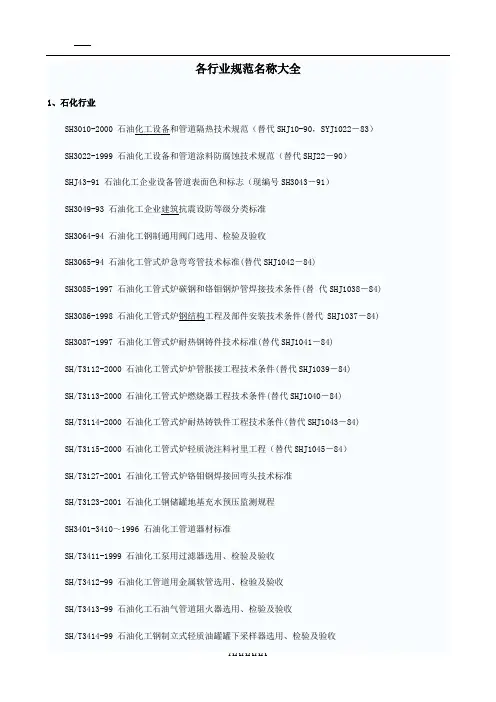
各行业规范名称大全1、石化行业SH3010-2000 石油化工设备和管道隔热技术规范(替代SHJ10-90,SYJ1022-83)SH3022-1999 石油化工设备和管道涂料防腐蚀技术规范(替代SHJ22-90)SHJ43-91 石油化工企业设备管道表面色和标志(现编号SH3043-91)SH3049-93 石油化工企业建筑抗震设防等级分类标准SH3064-94 石油化工钢制通用阀门选用、检验及验收SH3065-94 石油化工管式炉急弯弯管技术标准(替代SHJ1042-84)SH3085-1997 石油化工管式炉碳钢和铬钼钢炉管焊接技术条件(替代SHJ1038-84) SH3086-1998 石油化工管式炉钢结构工程及部件安装技术条件(替代 SHJ1037-84) SH3087-1997 石油化工管式炉耐热钢铸件技术标准(替代SHJ1041-84)SH/T3112-2000 石油化工管式炉炉管胀接工程技术条件(替代SHJ1039-84)SH/T3113-2000 石油化工管式炉燃烧器工程技术条件(替代SHJ1040-84)SH/T3114-2000 石油化工管式炉耐热铸铁件工程技术条件(替代SHJ1043-84)SH/T3115-2000 石油化工管式炉轻质浇注料衬里工程(替代SHJ1045-84)SH/T3127-2001 石油化工管式炉铬钼钢焊接回弯头技术标准SH/T3123-2001 石油化工钢储罐地基充水预压监测规程SH3401-3410~1996 石油化工管道器材标准SH/T3411-1999 石油化工泵用过滤器选用、检验及验收SH/T3412-99 石油化工管道用金属软管选用、检验及验收SH/T3413-99 石油化工石油气管道阻火器选用、检验及验收SH/T3414-99 石油化工钢制立式轻质油罐罐下采样器选用、检验及验收SH3501-2002 石油化工有毒、可燃介质管道工程施工及验收规范SH3502-2000 钛管道施工及验收规范(替代SHJ502-82)SH3503-2001 石油化工工程建设交工技术文件规定SH3504-2000 催化裂化装置反应、再生设备施工及验收规范(替代SHJ504-86)SH3505-1999 石油化工施工安全技术规程SH3506-2000 管式炉安装工程施工及验收规范(替代SHJ506-87)SH3507-1999 石油化工钢结构工程施工验收规范(替代SHJ507-87)SH3508-96 石油化工工程施工及验收统一标准(替代SHJ508-88)SH3510-2000 石油化工设备混凝土基础工程施工及验收规范(替代SHJ510-88)SH/T3511-2000 乙烯装置裂解炉施工技术规程(替代SHJ511-89)SH/T3512-2002 球形储罐工程施工工艺标准(替代SH/T3512-90)SH3513-2000 石油化工铝制料仓施工及验收规范(替代SHJ513-90)SH3514-2001 石油化工设备安装工程质量检验评定标准SHJ515-90 大型设备吊装工程施工工艺标准(现编号SH/T3515-90)SH/T3516-2001 催化裂化装置轴流压缩机—烟气轮机机组施工技术规程(替代SHJ516-90) SH/T3517-2001 石油化工钢制管道工程施工工艺标准(替代SH/T3517-91)SH3518-2000 阀门检验与管理规程(替代SHJ518-91)SH/T3519-2002 乙烯装置离心压缩机组施工技术规程(替代SH/T3519-91)SH3520-91 石油化工工程铬钼耐热钢管道焊接技术规程(替代SHJ520-91)SH3521-99 石油化工仪表工程施工技术规程(替代SHJ521-91)SH/T3522-91 石油化工绝热工程施工工艺标准(替代SHJ522-91)SH/T3523-1999 石油化工铬镍奥氏体钢、铁镍合金和镍合金管道焊接规程(替代SH3523-91)SH/T3524-1999 石油化工钢制塔、容器现场组焊施工工艺标准(替代SHJ524-92)SH3525-92 石油化工低温钢焊接规程SH3526-92 石油化工异种钢焊接规程SH/T3527-1999 石油化工不锈钢复合钢焊接规程(替代SH3527-1992)SH3528-93 石油化工钢储罐地基与基础施工及验收规范SH3529-93 石油化工企业厂区竖向布置工程施工及验收规范SH/T3530-2001 石油化工立式圆筒形钢制储罐施工工艺标准(替代SH3530-93)SH3531-1999 隔热耐磨混凝土衬里技术规范(替代SH3531-94)SH3532-95 石油化工换热设备施工及验收规范SH3533-95 石油化工给水排水管道工程施工及验收规范SH3534-2001 石油化工筑炉工程施工及验收规范SH/T3535-2002 石油化工混凝土水池工程施工及验收规范SH/T3536-2002 石油化工工程起重施工规范SHSG-035-89 施工现场中的设备材料代导则(试行)SHSG-039-89 施工图设计交底会规定(试行)2、石油天然气SY0055-2003* 长距离输油输气管道测量规范(替代SY0055-93)SY0401-98 输油输气管道线路工程施工及验收规范(替代SYJ4001-90)SY0402-2000 石油天然气站内工艺管线工程施工及验收规范(替代SYJ4023-89,SYJ4002-90, SY/ T4067-93)SY/T0407-97 涂装前钢材表面预处理规范(替代SYJ4007-86)SY/T0413—2002* 埋地钢质管道聚乙烯防腐层技术标准(SY/T4013-95)SY/T0414-98 钢质管道聚乙烯胶粘带防腐层技术标准(替代SY4014-93)SY/T0415—96 埋地钢质管道硬质聚氨脂泡沫塑料防腐保温层技术标准(替代SYJ18-86,SYJ4015-8 7,SYJ4016-87)SY/T0420-97 埋地钢质管道石油沥青防腐层技术标准(替代SYJ4020-88,SYJ8-84)SY0422-97 油田集输管道施工及验收规范(替代SYJ4022-88,SYJ4009-86,SYJ4061-93)SY/T0429-2000 石油建设工程质量检验评定标准输油输气管道线路工程SY/T0447-96 埋地钢质管道环氧煤沥青防腐层技术标准(替代SYJ28-87,SYJ4047-90)SY/T0452-2002 石油天然气金属管道焊接工艺评定(替代SY4052-92)SY/T0453-98 石油建设工程质量检验评定标准油田集输管道工程(替代SY4053-93)SY/T0460-2000 天然气净化装置设备与管道安装工程施工及验收规范(替代SY4060-93)SY0466-2000* 天然气集输管道施工及验收规范(替代SY0466-97,SY/T4082-95)SY0470-2000 石油天然气管道跨越工程施工及验收规范(替代SY4070-93)SY/T4028-93 石油建设工程质量检验评定标准设备安装工程(替代SYJn4028-88)SY/T4032.1-93 石油建设工程质量检验评定标准通信工程(长途通信明线线路工程)(替代SYJn403 2-88)SY/T4056-93 石油天然气钢制管道对接焊缝射线照相及质量分级SY4058-93 埋地钢质管道外防腐层和保温层现场补口补伤施工及验收规范SY/T4065-93 石油天然气钢制管道对接焊缝超声波探伤及质量分级SY/T4079-95 石油天然气管道穿越工程施工及验收规范SY5036-83 承压流体输送用螺旋缝埋弧焊钢管SY5038-83 承压流体输送用螺旋缝高频焊钢管SY5039-83 一般低压流体输送用螺旋缝高频焊钢管SYJ4006-90 长输管道阴极保护工程施工及验收规范(替代SYJ4006-84)3、水利行业SDJ226-87 架空送电线路导线及避雷线液压施工工艺规程(试行) SDJ276-90 架空电力线外爆压接施工工艺规程SDJ277-90 架空电力线内爆压接施工工艺规程SDJ279-90 电力建设施工及验收技术规范(热工仪表及控制装置篇) SDJ68-85 火力发电厂热力设备和管道保温材料技术条件与检验方法4、冶金部YB3301-92 焊接H型钢YB9248-92 冲击法检测硬化砂浆抗压强度技术规程YB/T9259-98 冶金工程建设焊工考试规程YBJ204-83 YG胀锚螺栓施工技术暂行规定YBJ215-88 YJ树脂材料防腐蚀施工及验收规程YBJ216-88 压型金属设计施工规程YBJ231-91 钢筋阻锈剂使用技术规程5、电力行业标准DL612-1996 电力工业锅炉压力容器监察规程DL/T541-94. 钢熔化焊角焊缝射线照相方法和质量分级DL/T542-94. 钢熔化焊T形接头角焊缝超声波检验方法和质量分级DJ5007-92 电力建设施工及验收技术规范火力发电厂焊接篇DL5017-93. 压力钢管制造安装及验收规范DL5011-92.电力建设施工及验收技术规范汽轮机机组篇DL5031-94 电力建设施工及验收技术规范管道篇DLT5047-95. 电力建设施工及验收技术规范锅炉机组篇6、纺织总会标准FZ/T91020-1998.不锈钢设备制造工艺规程7、化学工业部标准HG20225-95. 化工金属管道工程施工及验收规范HG20580~20585-1998. 钢制化工容器六规定HG20592-20635-97. 钢制管法兰、垫片、紧固件HG21539-92. 钢筋混凝土独立式管架通用图HG21540-92. 钢筋混凝土纵梁式管架通用图HG21541-92. 焊接H型钢标准节点通用图HG21542-92. 单轨悬挂吊车梁通用图HG/T20640.1-2000-1(一)~(四). H型钢钢结构管架能用图集桁架式管架HG/T20644-1998. 变力弹簧支吊架HG/T21581-95 HK01~04. 自控安装图册HG/T21581-95 HK05~08. 自控安装图册HG/T21581-95 HK09~12. 自控安装图册HG/T21581-95. 自控安装图册;总说明、图形符号规定及材料库HG/T21610-96. 热轧普通型钢标准接点通用图(焊接连接)HG/T21611.1-96. 钢筋混凝土带式输送栈桥通用图HG/T21612~21613-96. 压焊钢格板通用图钢梯及钢栏杆通用图HG/T21617-1998. 槽型锚定轨预埋件通用图HG/T21629-1999(一)~(五). 钢支架标准图HG/T21640.2-2000. H型钢钢结构管架通用图集纵梁式管架HG/T21640.3-2000. H型钢钢结构管架通用图集独立式管架8、机械工业部标准JB4708-2000. 钢制压力容器焊接工艺评定JB4708-2000. 钢制压力容器焊接工艺评定标准释义JB4712、13、24、25-92. 容器支座JB4714-92. 浮头式换热器和冷凝器型式与基本参数JB4715-92. 固定管板式换热器型式与基本参数JB4716-92. 立式热虹吸式重沸器型式与基本参数JB4717-92. U形管式换热器型式与基本参数JB4718-92. 管壳式换热器用金属包垫片JB4719-92. 管壳式换热器用缠绕垫片JB4720-92. 管壳式换热器用非金属垫片JB4721-92. 外头盖铡法兰JB4722-92. 管壳式换热器用螺纹换垫管基本参数和技术条件JB4723-92. 不可拆式螺旋板换热器型式与基本参数JB4726-28 41-43-2000. 压力容器用钢锻件JB4730-94. 压力容器无损检测JB/T4700-4707-2000. 压力容器法兰JB/T4735-1997. 钢制焊接常压容器JB/T4736-2002 JBT4746-2002. 补强圈钢制压力容器用封头JB/T9212-1999. 常压钢质油罐焊缝超声波探伤9、石油化学工业总公司标准SH3010-2000. 石油化工设备和管道隔热技术规范SH3022-1999. 石油化工设备和管道涂料防腐技术规范SH3086-1998. 石油化工管式炉钢结构工程及部件安装技术条件SH3100-2000. 石油化工工程测量规范SH3401~3410-96. 石油化工管道器材标准SH 3501-2002. 石油化工剧毒、可燃介质管道工程施工及验收规范SH3502-2000. 钛管道施工及验收规范SH3504-2000. 催化裂化装置反应再生系统设备施工及验收规范SH3506-2000. 管式炉安装工程施工及验收规范SH3507-1999. 石油化工钢结构工程施工及验收规范SH3510-2000. 石油化工装置设备基础工程施工及验收规范SH/T3511-2000. 乙烯装置裂解炉施工技术规程SH3513-2000. 石油化工铝制料仓施工及验收规范SH3514-2001. 石油化工设备安装工程质量检验评定标准SH3518-2000. 阀门检验与管理规程SH3521-1999. 石油化工仪表工程施工技术规程SHT3523-1999. 石油化工铬镍奥氏体钢、铁镍合金和镍合金管道焊接规程SH3524-1999. 石油化工钢制塔、容器现场组焊施工工艺标准SH/T3527-1999. 石油化工不锈复合钢焊接规程SH/T801-2000. 电缆桥架安装图10、石油天然气工业总公司标准SY0401-98. 输油输气管道线路工程施工及验收规范SY0422-97. 油田集输管道施工及验收规范SY0453-98. 石油建设工程质量检验评定标准油田集输管道工程SY4025-93. 石油建设工程质量检验评定标准建筑工程SY4028-93. 石油建设工程质量检验评定标准设备安装工程SY4030.1-93. 石油建设工程质量检验评定标准架空电力线路工程SY4030.2-93. 石油建设工程质量检验评定标准电气装置安装SY4031-93. 石油建设工程质量检验评定标准自动化仪表安装工程SY4056-93. 石油天然气钢制管道对射线照相及质量分级及条文说明SY4060-93. 天然气净化装置设备与管道安装工程施工及验收规范SY4065-93. 石油天然气钢制管道对接焊缝超声波探伤及质量分级及条文说明SY4081-95. 钢制球形储罐抗震鉴定技术标准SYJ4051-91. 油气田集输工艺管道动火安全技术规程SY/T0063-1999. 管道防腐层检漏试验方法SY/T0319-98. 钢制储罐液体环氧涂料内防腐层技术标准SY/T0320-98. 钢制储罐氯磺化聚乙烯外防腐层技术标准SY/T0379-98. 埋地钢制管道煤焦油瓷漆外防腐层标准SY/T0403-98. 输油泵组施工及验收规范SY/T0404-98. 加热炉工程施工及验收规范SY/T0407-97. 涂装前钢材表面预处理规范SY/T0414-98. 钢质管道聚乙烯胶粘带防腐层技术标准SY/T0419-97. 油田专用水套加热炉制造安装及验收规范SY/T0420-97. 埋地钢质管道石油沥青防腐涂层技术标准SY/T0442-97. 钢质管道熔结环氧粉末内涂层技术标准SY/T0443-98. 常压钢制焊接储罐及管道渗透检测技术标准SY/T0444-98. 常压钢制焊接储罐及管道磁粉检测技术标准SY/T0447-96. 埋地钢质管道环氧煤沥青防腐层技术标准SY/T0448-97. 油田、油气田用钢制压力容器施工及验收规范SY/T0449-97. 油气田钢制常压容器施工及验收规范SY/T0469-98. 石油建设工程质量检验评定标准油田钢制容器及加热炉制作SY/T0511-1996. 石油储罐呼吸器阀SY/T0512-1996. 石油储罐阻火器SY/T0515-1997. 油气分离器规范SY/T4055-93. 球形储罐γ射线全景暴光技术要求及条文说明SY/T4080-95. 管道储罐渗漏检测方法11、冶金工业部标准YB4102-2000. 低中压锅炉用电焊钢管YB4103-2000. 换热器用焊接钢管YB9010-98.岩土工程验收和质量评定标准YB9254-95. 钢结构制作安装施工规程YB9257-96. 钢结构检测评定及加固技术规程YB/T146-1998. 预应力钢丝及钢绞线用热轧盘条YB/T150-1998. 耐火缓冲泥浆YB/T9009-98. 岩土工程勘察成果检查、验收和质量评定标准YB/T9231-98. 钢筋阻锈剂使用技术规程YB/T9256-96. 钢结构管道涂装技术规程YB/T9259-98. 冶金工程建设焊工考试规程YB/T9261-98. 水泥基灌浆材料施工技术规程国家技术法规劳部发(1996)140号压力管道安全管理与监察规定质技监局锅发(1999)154号. 压力容器安全技术监察规程质技监局锅发(2000)99号. 压力管道安装单位资格认可实施细则(2000版)压力管道文件汇编.出师表两汉:诸葛亮先帝创业未半而中道崩殂,今天下三分,益州疲弊,此诚危急存亡之秋也。
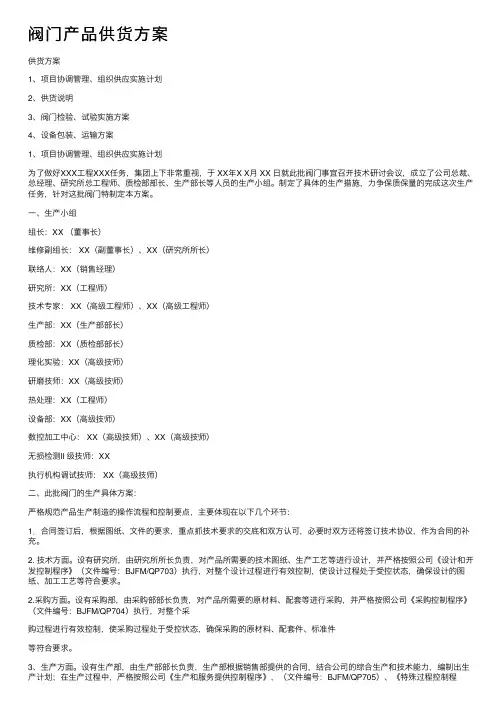
阀门产品供货⽅案供货⽅案1、项⽬协调管理、组织供应实施计划2、供货说明3、阀门检验、试验实施⽅案4、设备包装、运输⽅案1、项⽬协调管理、组织供应实施计划为了做好XXX⼯程XXX任务,集团上下⾮常重视,于 XX年X X⽉ XX ⽇就此批阀门事宜召开技术研讨会议,成⽴了公司总裁、总经理、研究所总⼯程师、质检部部长、⽣产部长等⼈员的⽣产⼩组。
制定了具体的⽣产措施,⼒争保质保量的完成这次⽣产任务,针对这批阀门特制定本⽅案。
⼀、⽣产⼩组组长:XX (董事长)维修副组长: XX(副董事长)、XX(研究所所长)联络⼈:XX(销售经理)研究所:XX(⼯程师)技术专家: XX(⾼级⼯程师)、XX(⾼级⼯程师)⽣产部:XX(⽣产部部长)质检部:XX(质检部部长)理化实验:XX(⾼级技师)研磨技师:XX(⾼级技师)热处理:XX(⼯程师)设备部:XX(⾼级技师)数控加⼯中⼼: XX(⾼级技师)、XX(⾼级技师)⽆损检测II 级技师:XX执⾏机构调试技师: XX(⾼级技师)⼆、此批阀门的⽣产具体⽅案:严格规范产品⽣产制造的操作流程和控制要点,主要体现在以下⼏个环节:1.合同签订后,根据图纸、⽂件的要求,重点抓技术要求的交底和双⽅认可,必要时双⽅还将签订技术协议,作为合同的补充。
2. 技术⽅⾯。
设有研究所,由研究所所长负责,对产品所需要的技术图纸、⽣产⼯艺等进⾏设计,并严格按照公司《设计和开发控制程序》(⽂件编号:BJFM/QP703)执⾏,对整个设计过程进⾏有效控制,使设计过程处于受控状态,确保设计的图纸、加⼯⼯艺等符合要求。
2.采购⽅⾯。
设有采购部,由采购部部长负责,对产品所需要的原材料、配套等进⾏采购,并严格按照公司《采购控制程序》(⽂件编号:BJFM/QP704)执⾏,对整个采购过程进⾏有效控制,使采购过程处于受控状态,确保采购的原材料、配套件、标准件等符合要求。
3、⽣产⽅⾯。
设有⽣产部,由⽣产部部长负责,⽣产部根据销售部提供的合同,结合公司的综合⽣产和技术能⼒,编制出⽣产计划;在⽣产过程中,严格按照公司《⽣产和服务提供控制程序》,(⽂件编号:BJFM/QP705)、《特殊过程控制程序》、《产品标识和可追溯性控制程序》、《产品防护控制程序》、《监视和测量装置控制程序》等相关程序执⾏。
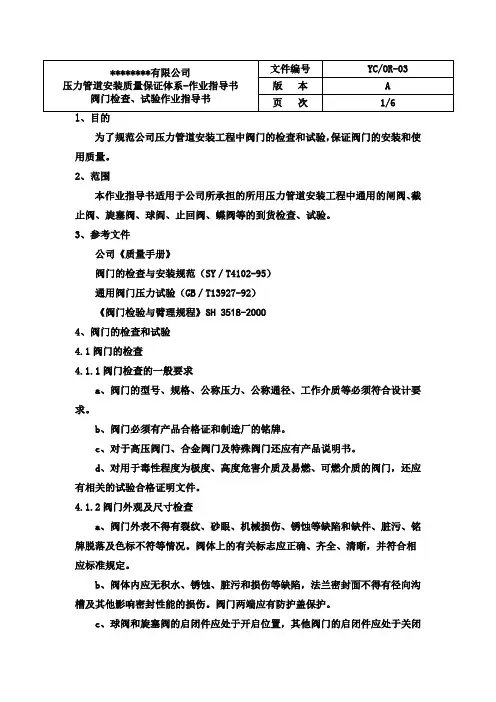
为了规范公司压力管道安装工程中阀门的检查和试验,保证阀门的安装和使用质量。
2、范围本作业指导书适用于公司所承担的所用压力管道安装工程中通用的闸阀、截止阀、旋塞阀、球阎、止回阀、蝶阀等的到货检查、试验。
3、参考文件公司《质量手册》阀门的检查与安装规范(SY/T4102-95)通用阀门压力试验(GB/T13927-92)《阀门检验与臂理规程》SH 3518-20004、阀门的检查和试验4.1阀门的检查4.1.1阀门检查的一般要求a、阀门的型号、规格、公称压力、公称通径、工作介质等必须符合设计要求。
b、阀门必须有产品合格证和制造厂的铭牌。
c、对于高压阀门、合金阀门及特殊阀门还应有产品说明书。
d、对用于毒性程度为极度、高度危害介质及易燃、可燃介质的阀门,还应有相关的试验合格证明文件。
4.1.2阀门外观及尺寸检查a、阀门外表不得有裂纹、砂眼、机械损伤、锈蚀等缺陷和缺件、脏污、铭牌脱落及色标不符等情况。
阀体上的有关标志应正确、齐全、清晰,并符合相应标准规定。
b、阀体内应无积水、锈蚀、脏污和损伤等缺陷,法兰密封面不得有径向沟槽及其他影响密封性能的损伤。
阀门两端应有防护盖保护。
c、球阀和旋塞阀的启闭件应处于开启位置,其他阀门的启闭件应处于关闭位置,止回阀的启闭件应处于关闭位置并作临时固定。
d、阀门的手柄或手轮应操作灵活轻便,无卡涩现象。
止回阀的阀瓣或阀芯应动作灵活正确,无偏心、移位或歪斜现象。
e、主要零部件如阀杆、阀杆螺母、连接螺母的螺纹应光洁,不得有毛刺、凹疤与裂纹等缺陷,外露的螺纹部分应予以保护。
20%,若仍有不合格,则该批阀门不得使用。
4.2阀门的试验4.2.1阀门试验的一般规定a、检查合格的阀门,在试验前应逐一核对阀门的规格、型号、公称压力、工作温度。
阀门试验在阀门试验站的试验区进行。
b、阀门试验(包括壳体试验、密封试验)应在专设的试验场地(阀门试验站的试验区)进行。
设计无特殊要求时,一般在常温下进行。
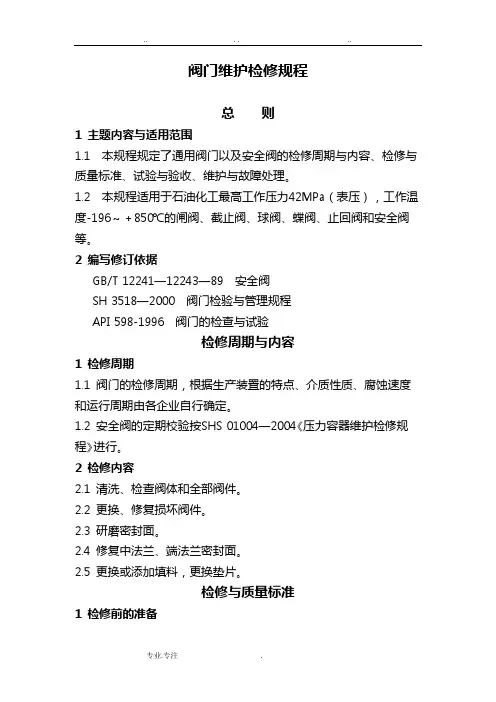
阀门维护检修规程总则1 主题内容与适用范围1.1 本规程规定了通用阀门以及安全阀的检修周期与内容、检修与质量标准、试验与验收、维护与故障处理。
1.2 本规程适用于石油化工最高工作压力42MPa(表压),工作温度-196~+850℃的闸阀、截止阀、球阀、蝶阀、止回阀和安全阀等。
2 编写修订依据GB/T 12241—12243—89 安全阀SH 3518—2000 阀门检验与管理规程API 598-1996 阀门的检查与试验检修周期与内容1 检修周期1.1 阀门的检修周期,根据生产装置的特点、介质性质、腐蚀速度和运行周期由各企业自行确定。
1.2 安全阀的定期校验按SHS 01004—2004《压力容器维护检修规程》进行。
2 检修内容2.1 清洗、检查阀体和全部阀件。
2.2 更换、修复损坏阀件。
2.3 研磨密封面。
2.4 修复中法兰、端法兰密封面。
2.5 更换或添加填料,更换垫片。
检修与质量标准1 检修前的准备1.1 备齐有关技术资料。
1.2 备齐机具、量具和材料。
1.3 阀内介质清理干净,并符合安全规定。
2 一般规定2.1 阀门应挂牌,标明检修编号、工作压力、工作温度及介质。
2.2 如有方向和位置要求的拆卸的阀件应核对或打上标记。
2.3 全部阀件进行清洗和除垢。
2.4 非金属材料的密封面损坏后,应予更换。
2.5 密封面研磨的研具材料及磨料的选用参照附录A(参考件)、附录B(参考件)、和附录C(参考件)。
2.6 工作温度高于250℃的螺栓及垫片应涂防咬合剂。
2.7 铜垫安装前应做退火处理。
2.8 螺栓应安装整齐。
拧紧中法兰螺栓时,闸阀、截止阀应处于开启状态。
2.9 阀门每经过次修理,应在阀体上做出明显标记。
3 检修质量标准3.1 阀门铭牌完整,安全阀铅封无损。
3.2 阀门的铸件不得有裂纹、缩孔和夹渣等缺陷。
3.3 阀门的锻件加工面应无夹层、重皮、裂纹、斑疤等缺陷。
3.4 阀门的焊接件焊缝应无裂纹、夹渣、气孔、咬肉和成形不良等缺陷。

东营联合石化有限责任公司阀门试验管理规定一、适用范围(一)本篇适用于联合石化工程中设计压力400Pa(绝压)至100MPa(表压),设计温度200℃至850℃的石油化工通用的铸铁、碳素钢、合金钢、不锈钢和部分有色金属阀门安装前的压力试验及施工过程中对阀门质量进行的检验等管理工作。
(二)本篇不适用于非金属的阀门,电站用的管道阀门、有衬里材料的阀门及仪表调节阀阀体的检验,但可参照本篇的有关内容。
二、开工条件控制阀门安装工程的开工应具备以下条件:(一)带控制点流程图、工艺专业施工图、有关技术文件及主要阀门使用说明书应齐全;(二)设计交底及施工图纸的自审、汇审均已完成;施工图审查主要内容是:核对阀门与图纸材料清单所列型号、规格、材质、数量等是否相符,阀门的压力等级与管道是否相称;(三)与阀门安装有关的主要施工方案已批准;(四)施工图预算和施工用料预算已经编制审批;(五)阀门及附件全部配套订货,其中主要阀门已到货,安装材料能保证施工的连续进行;(六)施工现场有必要的施工临时设施;(七)工艺管道安装已经进行;(八)施工人员已进行必要的技术培训和技术交底,特殊工种的施工人员具有有效的上岗合格证;(九)施工机具完好、齐备,检测工具在检定的有效周期内;(十)具备完善的质量管理组织。
三、施工工艺流程及关键控制环节(一)阀门施工程序图1 阀门施工程序图(二)关键控制环节从图1可以看出,阀门安装关键控制环节为:1、安全阀调试;2、阀门强度、严密性试验;3、高压、合金钢阀门解体及光谱试验、硬度检查。
四、质量标准及检验(一)本篇所采用的主要标准或规范GB/T 26480-2011 《阀门的检验和试验》;GB50235-2010 《工业金属管道工程施工规范》;SH3501-2011 《石油化工有毒、可燃介质钢制管道工程施工及验收规范》;SH3518-2000 《阀门检验与管理规程》;SH/T3064-2003 《石油化工钢制通用阀门选用、检验及验收》;GB/T13927-2008 《通用阀门的压力试验》;GB/T12241-2005 《安全阀一般要求》;GB/T12243-2005 《弹簧直接载荷式安全阀》;GB/T12244-2006 《减压阀一般要求》;GB/T12251-2005 《蒸汽疏水阀试验方法》;GB50484-2008 《石油化工建设工程施工安全技术规范》。
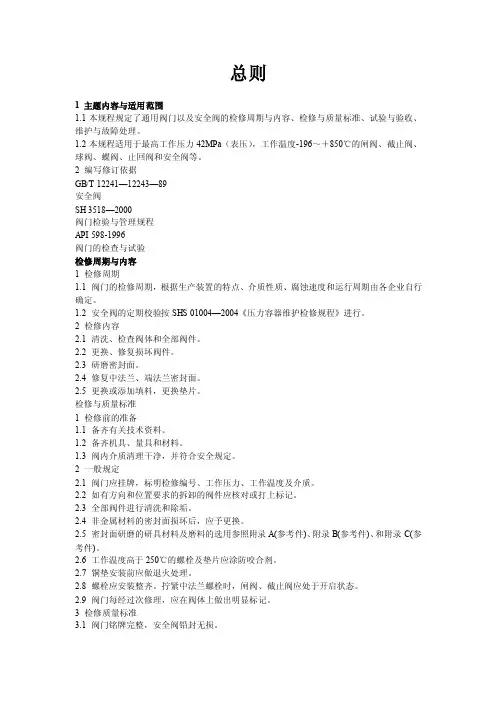
总则1 主题内容与适用范围1.1本规程规定了通用阀门以及安全阀的检修周期与内容、检修与质量标准、试验与验收、维护与故障处理。
1.2本规程适用于最高工作压力42MPa(表压),工作温度-196~+850℃的闸阀、截止阀、球阀、蝶阀、止回阀和安全阀等。
2 编写修订依据GB/T 12241—12243—89安全阀SH 3518—2000阀门检验与管理规程API 598-1996阀门的检查与试验检修周期与内容1 检修周期1.1 阀门的检修周期,根据生产装置的特点、介质性质、腐蚀速度和运行周期由各企业自行确定。
1.2 安全阀的定期校验按SHS 01004—2004《压力容器维护检修规程》进行。
2 检修内容2.1 清洗、检查阀体和全部阀件。
2.2 更换、修复损坏阀件。
2.3 研磨密封面。
2.4 修复中法兰、端法兰密封面。
2.5 更换或添加填料,更换垫片。
检修与质量标准1 检修前的准备1.1 备齐有关技术资料。
1.2 备齐机具、量具和材料。
1.3 阀内介质清理干净,并符合安全规定。
2 一般规定2.1 阀门应挂牌,标明检修编号、工作压力、工作温度及介质。
2.2 如有方向和位置要求的拆卸的阀件应核对或打上标记。
2.3 全部阀件进行清洗和除垢。
2.4 非金属材料的密封面损坏后,应予更换。
2.5 密封面研磨的研具材料及磨料的选用参照附录A(参考件)、附录B(参考件)、和附录C(参考件)。
2.6 工作温度高于250℃的螺栓及垫片应涂防咬合剂。
2.7 铜垫安装前应做退火处理。
2.8 螺栓应安装整齐。
拧紧中法兰螺栓时,闸阀、截止阀应处于开启状态。
2.9 阀门每经过次修理,应在阀体上做出明显标记。
3 检修质量标准3.1 阀门铭牌完整,安全阀铅封无损。
3.2 阀门的铸件不得有裂纹、缩孔和夹渣等缺陷。
3.3 阀门的锻件加工面应无夹层、重皮、裂纹、斑疤等缺陷。
3.4 阀门的焊接件焊缝应无裂纹、夹渣、气孔、咬肉和成形不良等缺陷。
3.5 阀门螺栓应满扣,无松动。

一、编制说明根据施工设计说明及相关阀门试验规程/规范,编制此阀门试验方案以确保圆满完成相关工艺管道阀门试验的施工任务。
二、编制依据1. 《阀门检验与管理规程》SH3518—20002. 《石油化工钢制通用阀门选用、检验及验收》SH/T3064—20033. 《工业金属管道施工及验收规范》GB50235—19974. 中国成达工程公司设计文件5. 中石油安全相关标准及规范三、阀门类别由于设计图纸没有出全,阀门类别及数量无法统计。
待设计图纸出全后再补充完整。
四、阀门检验1. 到货阀门必须有符合“阀门规格书”要求的质量证明文件,无质量证明文件的阀门不得使用;同时对质量证明文件进行审查并与实物核对。
若到货的阀门标识不清或与质量证明文件不符或对质量证明文件的特性数据、检验结果有异议,供货方应按相应标准作验证性检验或追溯到阀门制造单位。
异议未解决前,该批阀门不得使用。
2. 阀门的外观质量必须符合相应的产品标准的要求,不得有裂纹、氧化皮、粘砂、疏松等影响强度的缺陷;传动装置检查合格。
3. 阀门检验前向监理书面报告,在其和相关单位见证下进行阀门检验。
按照“阀门规格书”,对阀门的阀体、密封面及有特殊要求的垫片和填料的材质进行抽检,每批至少抽查一件,若有不合格,必须加倍抽检,若仍有不合格,则该批阀门不得使用,并作好标识和隔离。
合金钢阀门的阀体逐件进行光谱分析,不合格者不得使用,并作好标识和隔离,及时以“工作联系单”向监理和项目经理部报告。
4. 阀门检验合格后方可进行阀门试验。
五、阀门试验准备1. 阀门试验前,阀门试验方案须经逐级审批完毕,并向有关人员进行技术交底。
2. 做好阀门试验机具、设备的准备工作,压力表测量精度不低于1.5级,满刻度值为试验压力的1.5~2倍,经过校验合格并在有效期内。
3.阀门试验人员已配备并满足实际需要,质保体系健全。
4. 拟试验阀门已检验合格,已填写《阀门试验委托书》(样表附后)。
六、阀门试验1. 阀门试验内容为逐个对闸阀、截止阀、球阀、止回阀、蝶阀进行壳体压力试验、密封试验(以下阀门试验均指对闸阀、截止阀、球阀、止回阀、蝶阀的试验,不包括安全阀的调整试验)。
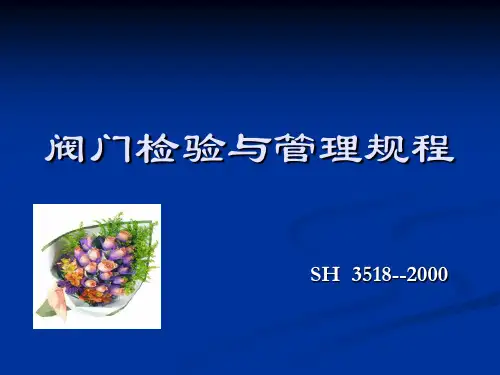

阀门验收规范1 范围本标准适用于工业管道、公用管道用金属阀门的检验和试验。
设计文件和顾客对阀门检验和试验另有要求时,应按要求进行。
2 规范性引用文件下列文件中的条款通过本标准的引用而成为本标准的条款,凡是注日期的引用文件,其随后的修改单(不含勘误的内容)或修订版均不适用于标准,然而,鼓励根据本部分达成协议的各方研究是否可使用这些文件的最新版本。
凡是不注日期的引用文件,其最新版本适用于本标准。
GB 50235—97 《工业金属管道工程施工及验收规范》HG 20225—95 《化工金属管道工程施工及验收规范》SH/T 3064—2003《石油化工钢制通用阀门选用、检验及验收》SH/T3517-2001 《石油化工钢制管道工程施工工艺技术规程》SH 3518 -2000 《阀门检验与管理规程》3 施工准备阀门试压站阀门检、试验应有独立的工作场地,如待试压件存放区、试压区、试压成品(合格品)区和不合格品区;试压厂房内通风、照明良好;阀门试压站应由健全的操作规程和管理制度。
主要施工设备、机具主要施工设备阀门试压机或电动试压泵、手动试压泵、小型空压机。
主要机具15T、30T、100T千斤顶、经计量合格的压力表、活动扳手、呆扳手、倒链、管钳、螺丝刀等主要工具:阀门试压器具消耗材料各种石棉橡胶板、胶皮、钳板、各种盘根。
4 施工工艺检验试验程序见图1。
试验场地设置和试压设备阀门合格证的检查外观检查阀门强度试验阀门严密性试验检验标志试验场地设置和试压设备阀门合格证的检查检验要求阀门必须具有出厂合格证和制造厂的铭牌,铭牌上应标明公称压力、公称直径、工作温度和工作介质等。
严密性试验不合格的阀门,必须解体检查或根据相关文件办理退库,阀门解体后,须重新试验。
合金钢阀门和高压阀门,每批应抽查10%,且不少于1个,进行解体检查内部零件,如有不合格,则需逐个检查。
阀门解体检查后,质量应符合下列要求:——阀座与阀体结合牢固。
——阀盖与阀体的配合良好。

阀门的质量管理
1、编制依据;《石油化工有毒、可燃介质管道工程施工及验收规范;》SH3501-2011; 《阀门检验与管理规范》SH3518-2000;
2、适用范围;浙江兴兴新能源科技有限公司30万吨年∕聚乙烯和39万吨∕丙烯工程DMTO项目;
3、采购方按设计图纸要求的规格、型号、压力、温度等级及流体特性选择合适的阀门;
4、制造方须执行技术协议所列的各项现行(国内国际)标准要求制造出合格产品;
5、阀门安装前,应逐个对阀体进行液体压力试验,试验压力为公称压力的1.5倍,停压5min无泄漏为合格。
6、具有上密封结构的阀门,应逐个对上密封面进行试验,试验压力为公称压力的1.1倍。
试验时应关闭上密封面,并松开填料压盖,停压4min,无泄漏为合格。
7、除按照《阀门的检验与管理规程》及《石油化工有毒、可燃介质管道工程施工及验收规范;》执行外,协议进口的阀门如有建造、监督、试压过程及提供的证明文件、资料的,承担运输过程意外及法律责任的可免重复试压。
8、各参建单位必须能承担或提供 (高、低压) 阀门试压场所及设施,并有监理对过程监督与控制;
9、为确保阀门质量合格,质量部将不定期对制造厂家、各阀门试压站及物装部所提供阀门进行监督性抽样检查。
阀门试验站检查要点
受检单位名称:检查日期:年月日检查结论:
2 ‘受检分值’应填写:达标或不达标;
3 ‘阀门检验能力评估’和‘检查结论’分4个等级:优、良、合格、不合格;
A类80%以上达标为合格; B类80%以上达标为良; C类75%以上达标为优(分值可四舍五入)。
4 安全阀校验由各施工成/分包商自行到有安全阀校验资质的单位进行校验。
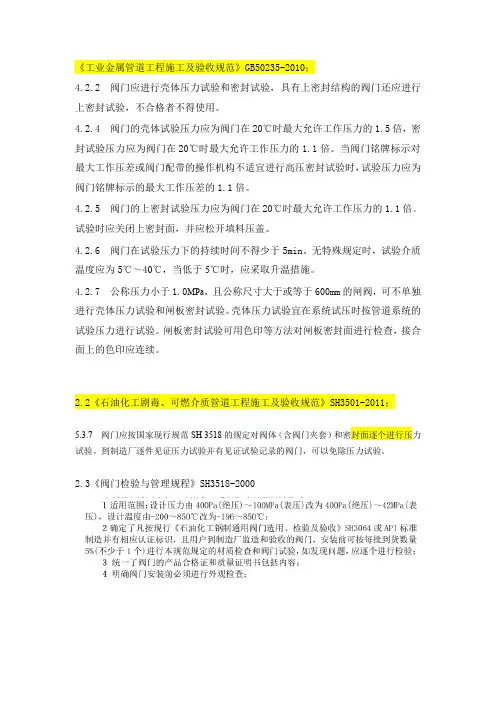
《工业金属管道工程施工及验收规范》GB50235-2010;
4.2.2阀门应进行壳体压力试验和密封试验,具有上密封结构的阀门还应进行上密封试验,不合格者不得使用。
4.2.4阀门的壳体试验压力应为阀门在20℃时最大允许工作压力的1.5倍,密封试验压力应为阀门在20℃时最大允许工作压力的1.1倍。
当阀门铭牌标示对最大工作压差或阀门配带的操作机构不适宜进行高压密封试验时,试验压力应为阀门铭牌标示的最大工作压差的1.1倍。
4.2.5阀门的上密封试验压力应为阀门在20℃时最大允许工作压力的1.1倍。
试验时应关闭上密封面,并应松开填料压盖。
4.2.6阀门在试验压力下的持续时间不得少于5min。
无特殊规定时,试验介质温度应为5℃~40℃,当低于5℃时,应采取升温措施。
4.2.7公称压力小于1.0MPa,且公称尺寸大于或等于600mm的闸阀,可不单独进行壳体压力试验和闸板密封试验。
壳体压力试验宜在系统试压时按管道系统的试验压力进行试验。
闸板密封试验可用色印等方法对闸板密封面进行检查,接合面上的色印应连续。
2.2《石油化工剧毒、可燃介质管道工程施工及验收规范》SH3501-2011;
5.3.7阀门应按国家现行规范SH3518的规定对阀体(含阀门夹套)和密封面逐个进行压力试验。
到制造厂逐件见证压力试验并有见证试验记录的阀门,可以免除压力试验。
2.3《阀门检验与管理规程》SH3518-2000
DL5031-94
4《石油化工钢制通用阀门选用、检验及验收》SH/T3064-2003;。
阀门检验与管理规程SH 3518-20001总则1.0.1为了与现行《石油化工剧毒、可燃介质管道工程施工及验收规范》SH3501规定的适用设计压力和温度范围相一致,设计压力由400Pa(绝压)~100MPa(表压)改为400Pa(绝压)~42MPa(表压);设计温度由一200℃~850℃改为一196℃~850℃。
1.0.2随着石油化工工业的发展,阀门的种类、结构特点等也会随之增多和改进,因此设计部门为了满足生产工艺上的需要,在阀门的选型时,可能会提出与本规程规定以外的一些要求,本条文是针对出现上述情况编写的。
1.0.3本条文中按国外标准制造的阀门,除包括随整套装置引进的和单独从国外购进的阀门外,同时也包括国内的阀门制造厂依据国外标准所制造的阀门。
1.0.5本条规定按现行SH3064标准制造或制造厂取得API认证,且用户到制造厂进行监检验收的阀门,施工单位安装前只进行外观检查,合格后即可安装。
编制本条时,考察了几个集团公司推荐的阀门生产厂家,发现这些厂有运行正常的质量保证体系,生产的阀门质量可靠,有的还出口美国、西欧、西亚及东南亚一些国家和地区,一般出口产品都按API、ANSI、BS、DIN等标准进行制造,国外用户直接到这些阀门厂进行监检或委托第三方监检,施工之前不再进行检验,直接安装。
编制本条对促进国内阀门制造厂产品质量的提高,降低石化装置建设成本,以及石化行业标准与国际接轨等,都有着积极的推动作用。
原规程1.0.2~1.0.4条取消,主要考虑到规范的1.0.1条已经明确使用范围,其他场合是否使用本规程,由使用单位自己决定。
原规程 1.0.7条取消,从现行的《石油化工钢制管道工程施工工艺标准》SHJ3517中没有找到阀门本身分类、分级说法。
2阀门检验2.1一般规定2.1.2考虑到使用的方便性,对产品质量证明文件包括的内容作出规定。
2.1.3内容意义与现行《石油化工剧毒、可燃介质管道施工及验收规范》SH3501的3.3.1条相同。
SH 3518-2000 标准阀门检验与管理规程本规程是根据中国石化(1995)建标字269号文的通知,由我公司对原《阀门检验与管理规程》SHJ518-91修订而成。
本规程共分四章和一个附录。
1、阀门检验与管理规程:总则2、阀门检验与管理规程:阀门检验3、阀门检验与管理规程:阀门试验4、阀门检验与管理规程:阀门管理5、阀门检验与管理规程:用词说明6、阀门检验与管理规程:条文说明1、总则本章节描述阀门检验与管理规程的总则。
1.0.1本规程适用于设计压力400Pa (绝压)〜42MPa (表压),设计温度-196〜850℃的石油化工通用铸铁、碳素钢、合金钢、不锈钢和铜、铝、钛等部分有色金属阀门安装前的检验及管理工作。
1.0.2设计文件中对阀门检验另有要求时,应按设计文件的要求执行。
1.0.3按国外标准制造的阀门,检验时应执行国外相应的检验标准。
1.0.4阀门检验工作中的安全技术和劳动防护应按国家现行有关法规、标准及《石油化工施工安全技术规程》SH3505的葙关规定执行。
1.0.5凡按现行《石油化工钢制通用阀门选用、检验及验收》SH3064或API标准制造并有相应认证标识,且用户到制造厂监造和验收的阀门,安装前可按每批到货数量5% (不少于1个)进行本规范规定的材质检查和阀门试验,如发现问题,应逐个进行检验。
2、阀门检验本章节描述阀门的检验。
2.1 —般规定2.1.1阀门必须具有质量证明文件。
阀体上应存制造厂铭牌,铭牌和阀体上应有制造厂名称、阀门型兮、公称压力、公称通径等标识,且应符合《通用阀H标志》GB12220的规定。
2.1.2阀门的产品质量证明文件应有如下内容:1制造厂名称及出厂日期:2产品名称、型号及规格;3公称压力、公称通径、适用介质及适用温度;4依据的标准、检验结论及检验曰期;5出厂编号;6检验人员及负责检验人员签章。
2. 1. 3设计要求作低温密封试验的阀门,应有制造厂的低温密封试验合格证明书。
SH中华人民共和国行业标准Industrial Standard of the People's Republic of China P SH 3518—2000阀门检验与管理规程Code for valves inspection and managementIssuance:30-06-2000 Implementation:01-10-2000 Issued by the State Bureau of Petroleum and Chemical Industry中华人民共和国行业标准Industrial Standard of the People's Republic of China阀门检验与管理规程Code for valves inspection and managementSH 3518-2000Mainly prepared by:Building and Installation Engineering Co. of Beijing YanshanPetrochemical Co., Ltd.Authorized by:China Petroleum and Chemical Group Co.Approved by:State Bureau of Petroleum and Chemical IndustryBeijing 2000Notice for the Approval of 10 Petrochemical IndustrialStandards Such As“Code for Design of Waste WaterTreatment in Petrochemical Enterprises”No.:SPCB(2000)239Sinopec,This is to notify that we have approved your protocol with regard to 10 petrochemical industrial standards such as Code for Design of Waster Water Treatment in Petrochemical Sectors. The following is the designations and numbers of these standards:Compulsory standards:No. Code No. of Standard Title of Standard1.SH3095-2000 Code for Design of Waste Water Treatment in PetrochemicalEnterprises2.SH3097-2000 Code for Design of Electrostatic Grounding in PetrochemicalIndustry3.SH3098-2000 Code for Design of Towers in Petrochemical Industry(toreplace SYJ 1049-83)4. SH3099-2000 Standard for the Quality of Water Supply and Drainage inPetrochemical Industry(to replace SHJ 1080-91)5.SH3100-2000 Code for Engineering Measurement in PetrochemicalIndustry6.SH3010-2000 Technical Specifications for the thermal Insulation ofEquipment and Piping in Petrochemical Industry(to replaceSHJ10-90 and SYJ 1022-83)7.SH3502-2000 Code for Construction and Acceptance of Ti piping(toreplace SHJ 502-82)8. SH3513-2000 Code for Construction and Acceptance of Aluminum Hopperin Petrochemical Industry(to replace SHJ 513-90)9.SH3518-2000 Regulation for Inspection and Management of Valves(toreplace SHJ 518-91)Recommended standards:No. Code No. of Standard Title of Standard1.SH/T3511-2000 Technical Regulations for the Cracker in Ethylene Plant(to replace SHJ 511-89)Oct. 1,2000 shall be the commencement date for implementation of the above standards and the ending date for the replaced standards.Regards,The State Petrochemical Industrial BureauJune 30,2000Content1. General Rules (5)2. Valve Inspection (6)2.1 General regulations (6)2.2 Appearance check (6)2.3 Check and test for valve driver (7)2.4 Other check and inspection (8)3. Valve Test (9)3.1 General regulations (9)3.2 Housing pressure test of valves (10)3.3 Sealing test of valves (10)3.4 Adjustment test for safety valves (13)3.5 Adjustment test for other valves (13)4. Management of Valves (14)4.1 Valve storage (14)4.2 Valve protection (14)4.3 Document management of valves (15)Description of Words (15)Attachment: Description of Clauses and Articles (16)1. General Rules1.0.1 This code is used for inspection and management for some nonferrous metal valves including general petrochemical – industrial cast iron, carbon steel, alloy steel and stainless steel, as well as copper, aluminum and titanium ones with design pressure of 400Pa (absolute pressure)~42Mpa (gauge pressure)and design temperature of –196~850℃before they are mounted.1.0.2 The valve inspection shall be conducted according to the design documentation unless otherwise specified in it.1.0.3 The relative external inspection standard should be followed for the valves produced in compliance with external standard when they are inspected.1.0.4 Safety technique and labor protection for valve inspection should be carried out according to the covering regulations in current national laws, standards and <<Constructive Safety Technique Rules of Petrochemical Industries>> SH350.1.0.5 For valves which are produced according to the current <<Selection for Use, Inspection and Acceptance of General Petrochemical-Industrial Steel Valves>> SH3064 or API Standard with relative certification identification, and supervised for manufacturing and accepted in the manufacturer’s plant by the customer, check for quality material and valve test specified in this code can be conducted by the number of 5% of each batch (not less than 1 piece) prior to mounting, and inspection shall be performed for them one by one if there are problems.2. Valve Inspection2.1 General regulations2.1.1 The valves must be accompanied by quality verification documentation. Manufacturer’s nameplate shall be located on the valve body, identifications such as manufacturer’s name, valve type, nominal pressure and nominal through diameter, etc shall be on the nameplate and valve body and they should conform to the regulations in <<General Valve Markings>> GB12220.2.1.2 The verification documentation of product quality for the valves should consist of the following:1. Manufacturer’s name and ex-factory date;2. Name, type and specification of product;3. Nominal pressure, nominal through diameter, suitable media and temperature;4. Followed standards, inspection conclusion and date;5. Ex-factory number;6. Signature and stamping by inspectors and the leader.2.1.3 Valves with low-temperature sealing test operated according to requirements of design should be accompanied by manufactur er’s low-temperature sealing test certificate.2.1.4 Magnetic particle and ray inspections for cast steel valves should be agreed between the customer and supplier. If it is necessary, the supplier shall operate according to the inspection standard required by the contract and make the inspection report.2.1.5 For the stainless valves with intercrystalline corrosion test being operated according to the requirements of design document, the manufacturer should provide the intercrystalline corrosion test certificate.2.1.6 Appearance inspection must be implemented before the valve is mounted.2.2 Appearance check2.2.1 For the transportation of valve, opening and closing position should conform to the following requirements:1. Valves including gate valve, globe valve, throttle valve, control valve, butterfly valveand foot valve should be fully closed.2. Closing components of the cock valve and ball valve should be all in fully openposition.3. Diaphragm valve shall be in closing position and not too tightly in order to prevent thediaphragm from damaging.4. Blades of check valve should be closed and fixed.2.2.2 Phenomena such as damage, lack of parts, corrosion or pull-off of the nameplate for the valves mustn’t be permitted, and it must not be dirty inside the valve body.2.2.3 There shall be protective cover on the two ends of valve. The handle and hand wheel should be flexibly operated without any jam.2.2.4 When the valve body is made from cast, its surface should be smooth and even without any defects such as crack, shrinkage cavity, blister, porosity or blur, etc; when it is forging, there should not be any defects such as crack, sandwich, cold-lap, scar or missing fillet on its surface.2.2.5 Movement of the blades or core for the check valve should be flexible and accurate without any eccentricity, shifting or aslant.2.2.6 Spring-type safety valve should have lead sealing and lever type safety shall have the location device for the weight.2.2.7 Rubber-lined, enamel-lined and plastic-lined inner surface of the valve body should be even and smooth, the lining and base shall be bonded firmly without any defects including cracks and bubble. The lining shall be qualified if it isn’t sparked over (white flash occurs) when surfaces of the lining are checked one by one by means of high-frequency spark igniter.2.2.8 Flange sealing face of the valve should meet the requirements without radial scratch.2.3 Check and test for valve driver2.3.1 For the valves used for the gear and worm gear to drive, their driving mechanism should be checked and cleaned according to the following requirements:1. The worm and worm gear should have good engagement and operate flexibly withoutjam or excessive wearing.2. The gear mating surface and bearing of the opening type mechanism should be cleanedand filled with new lubrication grease;3. Valves with closing type mechanism should be checked by 10% sampling and not lessthan 1 piece, inside the mechanism, it shall be clear without dirt and with complete parts, driving components have no blur as well as clearance among all parts and the mating surface should conform to the requirements. If problems are found, the driving mechanism of this batch of the valves should be checked one by one;4. Opening the cover to check, the lubrication grease of this batch of the valves should bereplaced if it is found to deteriorate.2.3.2 For the valves with chain wheel mechanism, its center surface of chain support andchain wheel shall keep in consistence. Check chain’s operation according to the working position, its movement should be smooth and not out of slot, the chain should have no defects such as decyclization, sealing off, rustiness or nonconformance with the chain’s pitch.2.3.3 The air pressure or hydraulic driven valves should have air or water as media, opening and closing check shall be performed according to piston’s working pressure. The valves should be tested for sealing when necessary.2.3.4 Gear-shift box of the electric valve shall be cleaned and checked in compliance with the rules specified in item 2.3.1 of this code, besides that, coaxiality of the couplers should be also rechecked, then the position limit device of the valve shall be checked and adjusted under status of fully opening or closing through connecting temporary power supply. Tests should be repeated not less than 3 times, with reliable movement of the electric system and accurate indication.2.3.5 Electromagnetic valves should be connected with the temporary power supply and tested for opening and closing not less than 3 times. If necessary, sealing test shall be performed under the condition of closing for the valves.2.3.6 Valves with mechanical interlock device should be tested and adjusted on the simulation support in mounting position. The two valves should have coordinated opening and closing movement, easy operation and accurate position limit.2.4 Other check and inspection2.4.1 Welding joint bevel of butt-welded connected valves should be conducted for magnetic powder or penetration tests according to the following regulations:1. The bevel of steel material with lower limitationσb≥540Mpa of nominal tensionstrength and Cr-Mo low alloy steel material should be checked by 100%;2. The bevel of non-austenitic stainless steel with design temperature less than or equal to-29℃should be checked by 5% sampling.2.4.2 The material quality of valve body for the alloy steel valves should be rechecked one by one by means of spectrum analysis or other methods, and make markings. The valves that don't conform to the requirements should not be used.2.4.3 Before the alloy steel valves and extremely toxic and flammable media pipe valves are mounted, material quality of the valve body, sealing face, specially required washer and fillings should be checked at random according to the “Valve Specification Manual” in the design documentation and at least one piece is sampled per batch. This batch of the valves can't be used if nonconformance is found.3. Valve Test3.1 General regulations3.1.1 Valve tests consist of housing pressure test, sealing test, adjusting test for the safety valve, pressure-relief valve and drainage valve.3.1.2 The housing pressure test and sealing test should be implemented for the number of checked valves defined in relative specification, for the valves with upper sealing structure, the upper sealing test shall be also conducted.3.1.3 The air, inertial gas, paraffin, water or non-corrosive liquid with viscosity not more than that of water can be selected as test media for the housing pressure test, upper sealing test and high pressure sealing test, air or inertial gas can be used as the media for low pressure sealing test.3.1.4 The antirust agent is permitted to add when using water as the media, the chloride content in water can’t exceed 100mg/L when operating test for austenitic stainless steel valves.3.1.5 Temperature of the test media should be 5~50℃if it is not specified particularly.3.1.6 Oily stain and dirt on the sealing face should be removed before valve test, and it is strictly forbidden to apply anti-leakage grease on it.3.1.7 Pressure gauge used for the test should be verified and qualified, as well as used within periodical calibration with precision not less than grade 1.5, its full scale value shall be 1.5~2 times as much as maximum measured pressure. The pressure gauges should not be less than 2 pieces for test system, and mounted respectively at the inlet of storage tank, equipment and tested valves.3.1.8 For the valves equipped with by-pass valves, the housing pressure test and sealing test should be also conducted for the by-pass valves.3.1.9 The air inside the valve shall be discharged completely when liquid is used as the test media, and accumulated liquid inside the valve shall be discharged in time after the pressure test of valve is finished.3.1.10 For qualified valves after verified by the tests, test identifications should be made in apparent parts on the valve body and test records shall be filled in. Valves without test identifications can’t be mounted or used.3.2 Housing pressure test of valve3.2.1 Test pressure of housing pressure test of valve shall be 1.5 times as much as nominal pressure of it.3.2.2 The shortest dwell time of housing pressure test is 5 min. there should be no drop leakage or moisture on external surface of the housing as well as no leakage in the bonding between the body and its lining, body and the cover if liquid is used as the media; perform the test according to specified leakage inspection method and leakage is forbidden if gas is used as the test media.3.2.3 For jacket valve, pressure test for the jacket portion should be conducted at pressure of 1.5 times as much as the working pressure.3.2.4 For gate valves with the nominal pressure less than 1Mpa and nominal through diameter more than or equal to 600mm, the housing pressure test can be operated non-individually and together with the pipe system test.3.3 Sealing test of valves3.3.1 The sealing tests of valve include upper sealing test, high pressure sealing test and low pressure test. They must be implemented after the housing pressure test is qualified.3.3.2 Items of the sealing tests of valve should be selected depending on diameter and pressure. They will be selected according to table 3.3.2-1 when the metric diameter is less than or equal to 100mm, nominal pressure is less than or equal to 25MPa as well as the metric diameter is more than 100mm, nominal pressure is less than or equal to 10MPa; they should be selected according to the table 3.3.2-2 when the metric diameter is less than or equal to 100mm, nominal pressure is more than 25MPa as well as the metric diameter is more than 100mm, nominal pressure is more than 10MPa.3.3.3 The test pressure for high sealing test and upper sealing test of valve shall be 1.1 times as much as the metric valve pressure, and 0.6MPa for the low pressure sealing test. It is qualified when the sealing face doesn’t leak. See the table 3.3.3 for the dwell time.3.3.4 The gate valve with nominal pressure less than 1Mpa and nominal through diameter more than or equal to 600mm can be tested for sealing non-individually, the sealing pair of valve sheet is suitable to be inspected through method of color printing. It shall be qualified to get continuous bonding face.Table 3.3.2-1 Sealing test of valvesNote: ① All valves are required for upper sealing test except bellows-sealed valvefeaturing upper sealing;② The high pressure sealing test shall be mandatory and low pressure sealing test be selectable for the lubricated cock valve;③ The valve manufacturer can operate the low pressure sealing test instead of high pressure sealing test under permission of the buyer;④ Sealing can be reduced of elastic seat valve if it is used at low pressure after the high pressure sealing test;⑤ For power operating globe valve, the high pressure sealing test shall be operated at 1.1 times as much as the design pressure difference while powervalve actuator specification is defined.Table 3.3.2-2 Sealing test of valvesNote: ① All valves with this kind of component are required for upper sealing test exceptbellows-sealed valve featuring upper sealing;②The valve manufacturer can operate the low pressure sealing test instead ofhigh pressure sealing test under permission of the buyer;③Sealing can be reduced of elastic seat valve if it is used at low pressure afterthe high pressure sealing test;④For power operating ball valve, the high pressure sealing test shall be operatedat 1.1 times as much as the design pressure difference while power valveactuator specification is defined.Table 3.3.3 Dwell time for sealing test3.3.5 Basic steps of the upper sealing test should be the following: sealing the inlet and outlet of the valve, loosen the packing gland, opening the valve and making the upper sealing close, filling the test media into the cavity, increasing the pressure to the test pressure gradually, it will be qualified till no leakage is found after reaching the specified dwell time.3.3.6 When performing the sealing test, the test media shall be filled fully with the cavity on one side of measured sealing pair in state of closing and the pressure shall be gradually increased to the test pressure, then visual inspection for leakage should be operated on the other side of this sealing pair after reaching the specified dwell time. Direction of introduced media and applied pressure shall conform to the following regulations:1. The introduced media and applied pressure shall be operated along the line of specifiedmedia flowing for valves such as the globe valve, etc, whose media flowing direction is defined;2. The introduced media and applied pressure shall be operated along each endrespectively for valves such as the gate valve, ball valve, cock valve and butterfly valve.3. The media can be introduced and pressure can be applied into the cavity between thetwo sealing pairs for valves with two sealing pairs.4. The media shall be introduced and pressure be applied along the closing line of valveblades for the check valve.3.4 Adjustment test for safety valves3.4.1 The adjustment test for the safety valve shall consist of the following items:1. Opening pressure:2. Returning-to-seat pressure;3. Repeatability of movement for the valve;4. Check frequent throb, flutter, jamming and other harmful vibration for the valve whenreturning to the seat by visual inspection or hearing.3.4.2 The safety valve shall be commissioned according to the design requirements. When it is not required in design, the opening pressure shall be 1.05~1.15 times as much as difference between the working pressure and back pressure, the returning-to-seat pressure shall be no less than 0.9 time of the working pressure.3.4.3 Media used for opening and returning-to-seat test for the safety valve shall be selected according to table 3.4.3.Table 3.4.3 Test mediaNote: The air shall be permitted if there is no suitable saturated vapor, but the safety valve should be re-commissioned when it is put into operation.3.4.4 The opening and returning-to-seat test for the safety valve should be conducted with no less than three times. The using department and relative units shall supervise and confirm it in site during the tests. Lead sealing shall be made, and “Test Record for the Safety Valve” shall be filled in after the tests are qualified.3.5 Adjustment test for other valves3.5.1 Pressure adjustment test for pressure-relief valve and movement test for drainage valve should be operated in system after it is mounted.3.5.2 Any adjustment for the pressure-relief valve should n’t be implemented during the test. It can t be re-adjusted without changing any parts until test conditions are changed ortest results deflect.3.5.3 Following requirements should be followed for test of the drainage valve:1. Movement is quick and operation is proper;2. There is no gas leakage for the valve seat;3. The valve should be in the state of full closing after drainage is completed;4. Double metal slice drainage valve should act within the rated working temperature.4. Management of Valves4.1 Valve storage4.1.1 The valves should be registered and accounted according to the main description on the nameplate when they are taken into or out of the storehouse. Test records and markings should be made for qualified valves verified by the test.4.1.2 The valves are suitable to be placed in the interior storehouse and respectively stored according to their specifications, types and material quality. Protective measures should be adopted when placing and preserving the nonferrous metal valves including titanium material ones which are not permitted for iron pollution and ultra-low-carbon stainless steel ones.4.1.3 Valves returned to the storehouse should be re-registered. Valves for which the housing pressure test and sealing test have been performed should be re-inspected prior to being used if their idle time exceeds half a year.4.1.4 Tackle mustn’t be directly bound up to the hand wheel or the valves shouldn’t be placed upside down during preservation and transportation of them.4.2 Valve protection4.2.1 The exposed part of valve stem should be greased for protection.4.2.2 The other closing components of the valve and sealing face of valve seat should be applied with industrial antirust grease except that plastic and rubber sealing face isn’t admitted to apply antirust agent.4.2.3 Interior cavity, flange sealing face and bolt thread of the valve should be applied with the antirust agent for protection.4.2.4 Interior of the valve should be cleaned and protective cover should be used on the two ends of it after its test is qualified.4.3 Document management of valves4.3.1 The quality verification document supplied by the manufacturer should correspond to the real material, and an account book should be established for management.4.3.2 Inspection department should give document including re-inspection report of material quality, valve test records and adjustment test records of the safety valve, and the relative personnel should make signature as well as special personnel should preserve for qualified valves verified through the tests.4.3.3 For the ex-factory valves, the quality verification document and relevant inspection and test records supplied by the manufacturer should be submitted to the relative department being as document of handing over the completed work in compliance with the requirements in current <<Technical Document Regulations of Handing over a Completed Project for Petrochemical Engineering Construction>>SH3503.Description of WordsDescription of words used for requiring to perform different degree of strictness in clauses of this code is as following:(I)For words expressing that it is very strict and must be done like that,“MUST” is adopted for positive ones;“STRICTLY FORBIDDEN” is adopted for negative ones.(II)For words expressing that it is strict and should be done like that in normal conditions,“SHALL” is adopted for positive ones;“SHALL NOT” or MUSTN’T is adopted for negative ones.(III)For words expressing that it is permitted to make selection a little and should be done like that at first when possible,“BE SUITABLE” is a dopted for positive ones;“NOT BE SUITABLE” is adopted for negative ones.“CAN” is adopted to express that it is selectable and can be done like that under certain conditions.中华人民共和国行业标准Industrial Standard of the People's Republic of China 阀门检验与管理规程Code for valves inspection and managementSH 3518-2000Description of Clauses and ArticlesBeijing 2000Content1. General Rules (18)2. Valve Inspection (19)2.1 General regulations (19)2.2 Appearance check (19)2.4 Other check and inspection (19)3. Valve Test (20)3.1 General regulations (20)3.2 Housing pressure test of valves (20)3.3 Sealing test of valve (20)3.4 Adjustment test for safety valves (21)4. Valve Management (21)4.1 Valve storage (21)4.3 Document management of Valves (21)1. General Rules1.0.1 The design pressure is changed from 400Pa(absolute pressure) ~100Mpa(gauge pressure) into 400Pa(absolute pressure)~42Mpa(gauge pressure)and design temperature from -200℃~850℃into –196℃~850℃in order to correspond with the practical design pressure and temperature scope specified in current <<Construction and Acceptance Specification for Extremely Toxic and Flammable Media Pipeline Engineering of Petrochemical Industry>> SH3501.1.0.2 The types and structure figures of valves will be increased and improved with development of the petrochemical industry, therefore the design department maybe set some requirements beyond regulations of this code when selecting valve types in order to meet the demand of production workmanship. This article is edited aiming at the conditions mentioned above.1.0.3 In this article, the valves produced according to the foreign standard, at the same time, including the ones made by internal valve manufacturers in compliance with the foreign standard, besides those introduced along with complete sets of equipment and purchased abroad individually.1.0.5 This article specifies that valves made according to the current SH3064 standard or whose manufacturer has gotten API certificate as well as supervised, checked and accepted in the manufacturer’s factory by the customer shall be only conducted with appearance check before mounting and can be mounted if they are qualified.When editing this article, some valve manufacturers recommended by several group corporations were investigated and they were found to have properly operating quality assurance system, the valves produced by them have a reliable quality and some of them which normally manufactured according to standards such as API, ANSI, BS and DIN have been exported to several countries and areas in the USA, Western Europe, Western Asia and Southeast Asia. External customers entrusted the third party to or directly supervise and check in the valve manufacturers, then perform mounting directly without any check before construction.Editing this article plays a positive promotion role to advance increasing of product quality for internal valve manufacturers, to decrease constructive cost of petrochemical device and make the petrochemical industrial standards in line with the international ones.Articles 1.0.2~1.0.4 of the old code have been deleted, in respect that application scope for article 1.0.1 of the specification is defined, so the departments whether using the specification on other occasions can decide by themselves.Article 1.0.7 in the old rule has been deleted, description for classification and grading for valves themselves can t be found in current “Construction Workmanship Standard f or。
阀门检测标准及阀门的技术要求一、总则采购时只明确规格、类别、工压就满足采购要求的作法,在当前市场经济环境里是不完善的.因为阀门制造厂家为了产品的竞争,各自均在阀门统一设计的构思下,进行不同的创新,形成了各自的企业标准及产品个性.因此在阀门采购时较详尽的提出技术要求,与厂家协调取得共识,作为阀门采购合同的附件是十分必要的.1.1正确选用阀门的意义正确选用阀门,对保证装置安全生产,提高阀门使用寿命,满足装置长周期运行是至关重要的.许多阀门事故的主要原因是阀门的选用不当,如在严寒地区使用了铸铁阀门,因油中含水积于阀体中,冬季结冻很容易冻裂阀门.在一些泵体出口阀门中,由于某些原因,所需流程较低而配用泵功率较大的场合,常常采用关小阀门来调节流量的办法.操作时,由于闸阀板局部打开,产生振动,加速了闸板与阀座密封表面的磨损,很容易造成阀门泄露.另外,阀门质量的好坏对生产使用也有很大影响.1.2选用阀门的原则(1)可靠性生产要求连续、平稳、长周期运行.因此,要求采用的阀门应有高的可靠性,安全系数大,不能因为阀门故障造成重大生产安全及人身伤亡事故;满足装置长周期运行的要求,长周期连续生产就是效益;另外,减少或避免由于阀门引起的“跑、冒、滴、漏”,创建清洁、文明工厂.(2)满足工艺生产要求阀门应满足操作介质、压力温度及用途需要,这也是阀门选用最基本的要求.例如需要阀门起超压保护作用,排放多余介质的,应选用安全阀、溢流阀;需要防止操作过程中介质回流的,应采用止回阀;需要自动排除蒸汽管道和设备中不断产生的冷凝水、空气及其他不可冷凝性气体,同时又要阻止蒸汽逸出的,应选用疏水阀.另外,对有腐蚀介质,应选用耐腐蚀材料阀体.(3)操作、安装、检维修方便阀门安装好后,应能使操作人员正确识别阀门方向、开度标志、指示信号,便于及时果断地处理各种应急故障.同时,所选阀门类型结构应尽量简单,安装、检维修方便.(4)经济性注意节约投资,降低装置成本,因此一般场合下要求,国内生产能满足使用要求的,应选用国产阀门;几种不同阀门类型都能满足使用要求的,应选用价格低廉的、结构简单的阀门;普通材质能满足使用要求的,不应选用较高等级的材质.二、适用标准阀门制造应执行下列技术标准GB12224-2005T 钢制阀门一般要求GB19672-2005 管线阀门技术条件JB/T450-1992 PN16.0~32.0MPa 锻造高压阀门、管件、紧固件技术条件JB-T 5300-91 通用阀门材料JB-T 53174-99 截止阀产品质量分等SH 3518-2000 阀门检验与管理规程GB/T12252 通用阀门供货要求YB25 钢中非金属夹杂物显微测定法JB755 压力容器锻件技术条件JB3963 压力容器锻件超声波探伤JB3965 钢制压力容器磁粉探伤若是企业标准,采购合同上应附企业文件.三、阀门材质3.1阀体材质,应以球墨铸铁为主,并注明牌号及铸铁实际的物理化学检测数据.3.2阀杆材质,力求不锈钢阀杆2CR13,大口径阀门也应是不锈钢嵌包的阀杆.3.3螺母材质,采用铸铝黄铜或铸铝青铜,且硬度与强度均大于阀杆.3.4阀杆衬套材质,其硬度与强度均应不大于阀杆,且在水浸泡状况下与阀杆、阀体不形成电化学腐蚀.3.5密封面的材质①阀门类别不一,密封方式及材质要求不一;②普通楔式,铜环的材质、固定方式、研磨方式均应说明;③软密封闸阀,阀板衬胶材料的物理化学及卫生检测数据;④蝶阀应标明阀体上密封面材质及蝶板上密封面材质;它们的物理化学检测数据,特别是橡胶的卫生要求、抗老化性能、耐磨性能;通常采用丁晴橡胶及三元乙丙橡胶等,严禁掺用再生胶.3.6阀轴填料①由于管网中的阀门,通常是启闭不频繁的,要求填料在数年内不活动,填料亦不老化,长期保持密封效果;②阀轴填料亦应在承受频繁启闭时,密封效果的良好性;③鉴于上述要求,阀轴填料力求终身不换或十多年不更换;④填料若需更换,阀门设计应考虑能有水压的状况下更换的措施.四.变速传动箱4.1箱体材质及内外防腐要求与阀体原则一致.4.2箱体应有密封措施,箱体组装后能承受3米水柱状况的浸泡.4.3箱体上的启闭限位装置,其调节螺帽应在箱体内或设在箱外,但需专用工具才可作业.4.4传动结构设计合理,启闭时只能带动阀轴旋转,不使其上下窜动,传动部件咬合适度,不产生带负荷启闭时分离打滑.4.5变速传动箱体与阀轴密封处不可连接成无泄漏的整体,否则应有可靠的防串漏措施.4.6箱体内无杂物,齿轮咬合部位应有润滑脂保护.五、阀门的操作机构5.1阀门操作时的启闭方向,一律应顺时针关闭.5.2由于管网中的阀门,经常是人工启闭,启闭转数不宜过多,就是大口径阀门亦应在200-600转内.5.3为了便于一个人的启闭操作,在管道工压状况下,最大启闭力矩宜为240N-m.5.4阀门启闭操作端应为方榫,且尺寸标准化,并面向地面,以便人们从地面上可直接操作.带轮盘的阀门不适用于地下管网.5.5阀门启闭程度的显示盘①阀门启闭程度的刻度线,应铸造在变速箱盖上或转换方向后的显示盘的外壳上,一律面向地面,刻度线刷上荧光粉,以示醒目;②指示盘针的材质在管理较好的情况下可用不锈钢板,否则为刷漆的钢板,切勿使用铝皮制作;③指示盘针醒目,固定牢靠,一旦启闭调节准确后,应以铆钉锁定.5.6若阀门埋设较深,操作机构及显示盘离地面距离≥1.5m时,应设有加长杆设施,且固定稳牢,以便人们从地面上观察及操作.也就是说,管网中的阀门启闭操作,不宜下井作业.六.阀门的性能检测6.1阀门某一规格批量制造时,应委托权威性机构进行以下性能的检测:①阀门在工压状况下的启闭力矩;②在工压状况下,能保证阀门关闭严密的连续启闭次数;③阀门在管道输水状况下的流阻系数的检测.6.2阀门在出厂前应进行以下的检测:①阀门在开启状况下,阀体应承受阀门工压值二倍的内压检测;②阀门的关闭状况下,两侧分别承受1.1倍阀门工压值,无渗漏;但金属密封的蝶阀,渗漏值亦不大于相关要求.七.阀门的内外防腐7.1阀体包括变速传动箱体内外,首先应抛丸清砂除锈,力求静电喷涂粉状无毒环氧树脂,厚度达0.3mm以上.特大型阀门静电喷涂无毒环氧树脂有困难时,亦应刷涂、喷涂相似的无毒环氧漆.7.2阀体内部以及阀板各个部位要求全面防腐,一方面浸泡在水中不会锈蚀,在两种金属之间不产生电化学腐蚀;二方面表面光滑使过水阻力减少.7.3阀体内防腐的环氧树脂或油漆的卫生要求,应有相应权威机关的检测报告.化学物理性能亦应符合相关要求.八.阀门包装运输8.1阀门两侧应设轻质堵板固封.8.2中、小口径阀门应以草绳捆扎,并以集装箱方式运输为宜.8.3大口径阀门亦有简易木条框架固体包装,以免运输过程中碰损.8.4阀门运输时的开闭位置应符合下列要求:a、闸阀、截止阀、节流阀、调节阀、蝶阀、底阀等阀门应处于全关闭位置;b、旋塞阀、球阀的关闭件均应处于全开启位置;c、隔膜阀应处于关闭位置,且不可关的过紧,以防止损坏隔膜;d、止回阀的阀瓣应关闭并予以固定.阀门不得有损坏、缺件、腐蚀、铭牌脱落等现象,且阀体内不得有脏污.阀门两端应有保护.手柄或手轮操作应灵活轻便,不得有卡涩现象.阀体为铸件时,其表面应平整光滑,无裂纹、缩孔、沙眼、气孔、毛刺等缺陷;阀体为锻件时,其表面应无裂纹、夹层、重皮、斑疤等缺陷.止回阀的阀瓣或阀芯动作灵活准确,无偏心、移位或歪斜现象.弹簧式安全阀应具有铅封,杠杆式安全阀应有重锤的定位装置.衬胶、衬搪瓷及衬塑的阀门内表面应平整光滑,衬层与基体结合牢固,无裂纹、鼓泡等缺陷,用高频电火花发生器逐个检查衬层表面,以未发现衬层被击穿产生白色闪光现象为合格.阀门法兰密封面应符合要求,且不得有径向划痕.九、阀门供货注意事项9.1一般要求阀门必须按其相应的技术标准、设计图样、技术文件及采购合同的规定进行制造.并经检验合格后,方可供货.当有特殊要求时,应在采购合同中规定,并应按规定要求检验和供货.阀门到货必须进行外观检查.9.2涂层1除奥氏体不锈钢及铜制阀门外,其他金属制阀门的非加工外表面应涂漆或按合同的规定予以涂层.2非涂漆或无防锈层的加工面,必须涂易除去的防锈剂.阀门内腔及零件不得涂漆,并应无污垢锈斑.9.3标志(1)阀门应具有清晰的标志,并符合GB 12220通用阀门标志的规定.(2)标牌应牢固地固定在阀门的明显部位,其内容必须齐全、正确,并应符合JB 8的规定,其材料应用不锈钢、铜合金或铝合金制造.9.4阀门的产品质量证明文件内容(1)制造厂名称及出厂日期;(2)产品名称、型号及规格;(3)公称压力、公称通径、适用介质及适用温度;(4)几何尺寸检查记录、阀体材质检查记录、压力试验记录(5)设计要求做试验的阀门,应有制造厂商的试验合格证明书附:阀门主要参数1.材料类别、工作温度2公称通径 DN3公称压力 FN4压力-温度额定值5适用介质6特殊介质。
(建筑工程管理)某公司年产万吨沥青装置安装工程阀门检验方案1.适用范围本方案适用于----------------------------------安装工程阀门安装前的检验及管理工作。
2.编制依据2.1SH3518—2000《阀门检验和管理规程》;2.2GB50235-97《工业金属管道工程施工及验收规范》2.3SH3503-2007《石油化工工程建设交工技术文件规定》;2.4FCC下发2005版《质量管理体系作业文件》;2.5FCC下发2005版《HSE体系文件》;2.6SH3501-2002《石油化工剧毒、可燃介质管道工程施工及验收规范》。
3.检验范围:3.1本标准适用于金属密封副、弹性密封副和非金属密封副(如陶瓷)的闸阀、截止阀、旋塞阀、球阀、止回阀和蝶阀的检验和压力试验。
经同意,也可适用于其他类型的阀门。
3.2疏水器的壳体检验。
3.3委托方另有要求时按委托方要求执行。
4.质量标准:阀门检验严格按SH3518-2000标准检验,按GB50235-97、SH3501-2002要求比例抽检,检验合格率100%。
5.实物量和检验工期:初步统计阀门约570台左右;阀门口径范围在DN15—DN800之间。
阀门检验工期1个月。
6.阀门检验的过程控制6.1阀门检验委托书:1)《阀门检验委托书》要求逐项填写,否则阀门检验站根据实际情况可拒收;阀门检验人员进行外观检查、数量清点合格后,可在《阀门检验委托书》上签字确认。
2)阀门检验站接收《阀门检验委托书》后方可对阀门进行检验。
3)阀门检验前由检验站管理人员按阀门委托的批次编制委托批号(其批号为批次流水号,用数字表示)且填入委托书。
6.2阀门检验试验记录:技术负责人审核检验员填写的“阀门检验试验记录”,且按SH3503-2007要求壹式五份打印“阀门检验记录”四份交委托单位,壹份检验站留存,待项目竣工后移交总站存档。
6.3检验不合格报总包方处理,检验合格的阀门报总包及监理确认(阀门试验确认表)。
UDC中华人民共和国行业标准P SH 3518-2000阀门检验与管理规程Code for valves inspection and management代替:SHJ 518—91主编单位:北京燕山石油化工有限公司建筑安装公司主编部门:中国石油化工集团公司批准部门:国家石油和化学工业局2000-06-30 发布 2000-10-01实施国家石油和化学工业局发布国家石油和化学工业局文件国石化政发(2000)239号 关于批准《石油化工企业污水处理设计规范》 等10项石油化工行业标准的通知 中国石油化工集团公司: 你公司报批的《石油化工企业污水处理设计规范》等10项石油化工行业标准草案,业经我局批准,现予发布。
标准名称、编号为: 强制性标准: 序号 标准编号 标准名称 1. SH3095—2000 石油化工企业污水处理设计规范 2. SH3097—2000 石油化工静电接地设计规范 3. SH3098—2000 石油化工塔器设计规范(代替SYJl049—83) 4. SH3099—2000 石油化工给排水水质标准(代替SHJ 1080—91) 5. SH3100—2000 石油化工工程测量规范 6. SH3010—2000 石油化工设备和管道隔热技术规范(代替 SHJl0-90和SYJl022-83) 7. SH3502—2000 钛管道施工及验收规范(代替SHJ 502—82) 8. SH3513—2000 石油化工铝制料仓施工及验收规范(代替SHJ 513-90) 9. SH3518—2000 阀门检验与管理规程(代替SHJ 518-91) 推荐性标准: 序号 标准编号 标准名称 1. SH/T3511—2000 乙烯装置裂解炉施工技术规程(代替SHJ 511-89) 以上标准自2000年10月1日起实施,被代替的标准同时废止。
国家石油和化学工业局 二000年六月三十日 前言本规程是根据中国石化(1995)建标字269号文的通知,由我公司对原《阀门检验与管理规程》SHJ518-91修订而成。
本规程共分四章和一个附录。
这次修订的主要内容有: 1适用范围:设计压力由400Pa(绝压)~100MPa(表压)改为400Pa(绝压)~42MPa(表压),设计温度由-200~850℃改为-196~850℃; 2确定了凡按现行《石油化工钢制通用阀门选用、检验及验收》SH3064或API标准制造并有相应认证标识,且用户到制造厂监造和验收的阀门,安装前可按每批到货数量5%(不少于1个)进行本规范规定的材质检查和阀门试验,如发现问题,应逐个进行检验; 3 统一了阀门的产品合格证和质量证明书包括内容; 4 明确阀门安装前必须进行外观检查; 5 取消了原规程“尺寸检查”一节; 6 将原规程“材质检查”与“解体检查”两节合并为“材质检查”一节; 7水中氯离子含量不超过25PPm改为水中氯化物含量不超过100mg/L; 8明确了阀门试验项目,将阀门强度试验改为壳体压力试验,保压时间规定为一定值; 9 将阀门密封试验分为高压密封试验和低压密封试验; 10 取消了原规程密封副最大渗漏量要求和计量方法; 11 取消了“阀门材质标志”一节。
在修订过程中,针对原规程中存在的问题,进行了广泛的调查研究,总结了近几年来石油化工企业阀门检验及管理的实践经验,搜集并吸取了国内外现行的有关规范,并征求了有关设计、施工、生 产等方面的意见,对其中主要问题进行了多次讨论,最后经审查定稿。
本规程在实施过程中,如发现需要修改补充之处,请将意见和有关资料提供给我公司,以便今后修订时参考。
我公司地址是 通讯地址:北京276信箱 邮政编码:102502 本规范主编单位和主要起草人 主编单位:北京燕山石油化工有限公司建筑安装工程公司 主要起草人:江波 沈金珠 1 总 则 1.0.1本规程适用于设计压力 400MPa(绝压)~42MPa(表压),设计温度-196~85℃的石油化工通用铸铁、碳素钢、不锈钢和铜、铝、钛等部分有色金属阀门安装前的检验及管理工作。
1.0.2设计文件中对阀门检验另有要求时,应按设计文件的要求执行。
1.0.3按国外标准制造的阀门,检验时应执行国外相应的检验标准。
1.0.4阀门检验工作中的安全技术和劳动防护应按国家现行有关法规、标准及《石化工施工安全技术规程》SH3505的有关规定执行。
1.0.5凡按现行《石油化工钢制通用阀门选用、检验及验收》SH3064或API标准制造并有相应认证标识,且用户到制造厂监造和验收的阀门,安装前可按每批到货数量5%(不少于1个)进行本规范规定的材质检查和阀门试验,如发现问题,应逐个进行检验。
2 阀 门 检 验 2.1 一 般 规 定 2.1.1 阀门必须具有质量证明文件。
阀体上应有制造厂铭牌,铭牌和阀体上应有制造厂名称、阀门型号、公称压力、公称通径等标识,且应符合《通用阀门标志》GBl2220的规定。
2.1.2 阀门的产品质量证明文件应有如下内容: 1 制造厂名称及出厂日期; 2 产品名称、型号及规格; 3 公称压力、公称通径、适用介质及适用温度; 4 依据的标准、检验结论及检验日期; 5 出厂编号; 6 检验人员及负责检验人员签章; 2.1.3 设计要求作低温密封试验的阀门,应有制造厂的低温密封试验合格证明书。
2.1.4 铸钢阀门的磁粉检验和射线检验由供需双方协定,如需检验,供方应按合同要求的检验标准进行检验,并出具检验报告。
2.1.5 设计文件要求进行晶间腐蚀试验的不锈钢阀门,制造厂应提供晶间腐蚀试验合格证明书。
2.1.6 阀门安装前必须进行外观检查。
2.2 外 观 检 查 2.2.1 阀门运输时的开闭位置应符合下列要求: 1 闸阀、截止阀、节流阀、调节阀、蝶阀、底阀等阀门应处于全关闭位置; 2 旋塞阀、球阀的关闭件均应处于全开启位置; 3 隔膜阀应处于关闭位置,且不可关得过紧,以防止损坏隔膜; 4 止回阀的阀瓣应关闭并予以固定。
2.2.2 阀门不得有损伤、缺件、腐蚀、铭牌脱落等现象.且阀体内不得有脏污。
2.2.3 阀门两端应有防护盖保护。
手柄或手轮操作应灵活轻便,不得有卡涩现象。
2.2.4 阀体为铸件时,其表面应平整光滑,无裂纹、缩孔、砂眼、气孔、毛刺等缺陷;阀体为锻件时,其表面应无裂纹、夹层、重皮,斑疤、缺肩等缺陷。
2.2.5 止回阀的阀瓣或阀芯动作应灵活准确,无偏心、移位或歪斜现象。
2.2.6 弹簧式安全阀应具有铅封;杠杆式安全阀应有重锤的定位装置。
2.2.7 衬胶、衬搪瓷及衬塑料的阀体内表面应平整光滑,衬层与基体结合牢固,无裂纹、鼓泡等缺陷,用高频电火花发生器逐个检查衬层表面,以未发现衬层被击穿(产生白色闪光现象)为合格。
2.2.8 阀门法兰密封面应符合要求,且不得有径向划痕。
2.3 阀门传动装置的检查与试验 2.3.1 采用齿轮、蜗轮传动的阀门,其传动机构应按下列要求进行检查与清洗: 1 蜗杆和蜗轮应啮合良好、工作轻便,无卡涩或过度磨损现象; 2 开式机构的齿轮啮合面、轴承等应清洗干净,并加注新润滑油脂; 3 有闭式机构的阀门应抽查10%且不少于一个,其机构零件应齐全、内部清洁无污物、传动件无毛刺、各部间隙及啮合面符合要求。
如有问题,应对该批阀门的传动机构逐个检查; 4 开盖检查如发现润滑油脂变质,将该批阀门的润滑油脂予以更换。
2.3.2 带链轮机构的阀门,链架与链轮的中心面应一致。
按工作位置检查链条的工作情况,链条运动应顺畅不脱槽,链条不得有开环、脱焊、锈蚀或链轮与链条节距不符等缺陷。
2.3.3 气压、液压传动的阀门,应以空气或水为介质,按活塞的工作压力进行开闭检验。
必要时,应对阀门进行密封试验。
2.3.4 电动阀门的变速箱除按本规程第2.3.1条的规定进行清洗和检查外,尚应复查联轴器的同轴度,然后接通临时电源,在全开或全闭的状态下,检查、调整阀门的限位装置,反复试验不少于三次,电动系统应动作可靠、指示准确。
2.3.5 电磁阀门应接通临时电源,进行开闭试验,且不得少于三次。
必要时应在阀门关闭状态下,对其进行密封试验。
2.3.6 具有机械联锁装置的阀门,应在安装位置的模拟架上进行试验和调整。
两阀门应启闭动作协调、工作轻便、限位准确。
2.4 其他检查和检验 2.4.1 对焊连接阀门的焊接接头坡口,应按下列规定进行磁粉或渗透检测: ≥540MPa的钢材及Cr-Mo低合金钢材的坡口应进行100% 1 标准抗拉强度下限值σb检测; 2 设计温度低于或等于-29℃的非奥氏体不锈钢坡口应抽检5%。
2.4.2 合金钢阀门应采用光谱分析或其他方法,逐个对阀体材质进行复查,并做标记。
不符合要求的阀门不得使用。
2.4.3 合金钢阀门和剧毒、可燃介质管道阀门安装前,应按设计文件中的“阀门规格书”对阀门的阀体、密封面以及有特殊要求的垫片和填料的材质进行抽查,每批至少抽查一件。
若有不合格,该批阀门不得使用。
3 阀 门 试 验 3.1 一 般 规 定 3.1.1 阀门试验包括壳体压力试验、密封试验和安全阀、减压阀、疏水阀的调整试验。
3.1.2 阀门应按相应规范确定的检查数量进行壳体压力试验和密封试验,具有上密封结构的阀门,还应进行上密封试验。
3.1.3 对于壳体压力试验、上密封试验和高压密封试验,试验介质可选择空气、惰性气体、煤油、水或粘度不高于水的非腐蚀性液体,低压密封试验介质可选择空气或惰性气体。
3.1.4 用水做试验介质时,允许添加防锈剂,奥氏体不锈钢阀门试验时,水中氯化物含量不得超过100mg/L。
3.1.5 无特殊规定时,试验介质的温度宜为5~50℃。
3.1.6 阀门试验前,应除去密封面上的油渍和污物,严禁在密封面上涂抹防渗漏的油脂。
3.1.7 试验用的压力表,应鉴定合格并在周检期内使用,精度不应低于1.5级,表的满刻度值宜为最大被测压力的1.5~2倍。
试验系统的压力表不应少于二块,并分别安装在贮罐、设备及被试验的阀门进口处。
3.1.8 装有旁通阀的阀门,旁通阀也应进行壳体压力试验和密封试验。
3.1.9 试验介质为液体时,应排净阀门内的空气,阀门试压完毕,应及时排除阀门内的积液。
3.1.10 经过试验合格的阀门,应在阀体明显部位做好试验标识,并填写试验记录。
没有试验标识的阀门不得安装和使用。
3.2 阀门壳体压力试验 3.2.1 阀门壳体压力试验的试验压力应为阀门公称压力的1.5倍。
3.2.2 阀门壳体压力试验最短保压时间应为5min。
如果试验介质为液体,壳体外表面不得有滴漏或潮湿现象,阀体与阀体衬里、阀体与阀盖接合处不得有泄漏;如果试验介质为气体,则应按规定的检漏方法检验,不得有泄漏现象。